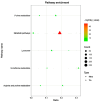Evaluation of Metabolic Characteristics Induced by Deoxynivalenol in 3D4/21 Cells
- PMID: 40805114
- PMCID: PMC12345648
- DOI: 10.3390/ani15152324
Evaluation of Metabolic Characteristics Induced by Deoxynivalenol in 3D4/21 Cells
Abstract
Deoxynivalenol (DON) is a common mycotoxin that causes immunosuppression in pigs. Its effects on cellular metabolism remain unclear. In this study, we investigate DON-induced metabolic alterations in porcine alveolar macrophage cell line 3D4/21 using non-targeted metabolomics. MTT assays showed DON reduced cell viability in a concentration- and time-dependent manner. Principal component analysis (PCA) and orthogonal partial least squares discriminant analysis (OPLS-DA) revealed distinct metabolic profiles between control and DON-treated groups. Metabolomic analysis identified 127 differential metabolites (VIP > 1, p < 0.05), primarily in purine metabolism, glutathione metabolism, and arginine-proline metabolism. Integration with transcriptomic data confirmed that these pathways play key roles in DON-induced immunotoxicity. Specifically, changes in purine metabolism suggested disrupted nucleotide synthesis and energy balance, while glutathione depletion indicated weakened antioxidant defense. These findings provided a systems biology perspective on DON's metabolic reprogramming of immune cells and identified potential therapeutic targets to reduce mycotoxin-related immunosuppression in swine.
Keywords: alveolar macrophages; deoxynivalenol; metabolomics; pig.
Conflict of interest statement
The authors declare no conflicts of interest.
Figures





Similar articles
-
Description of metabolic differences between castrated males and intact gilts obtained from high-throughput metabolomics of porcine plasma.J Anim Sci. 2025 Jan 4;103:skaf178. doi: 10.1093/jas/skaf178. J Anim Sci. 2025. PMID: 40407809 Free PMC article.
-
Prescription of Controlled Substances: Benefits and Risks.2025 Jul 6. In: StatPearls [Internet]. Treasure Island (FL): StatPearls Publishing; 2025 Jan–. 2025 Jul 6. In: StatPearls [Internet]. Treasure Island (FL): StatPearls Publishing; 2025 Jan–. PMID: 30726003 Free Books & Documents.
-
Integrated single-cell and transcriptomic analysis of bone marrow-derived metastatic neuroblastoma reveals molecular mechanisms of metabolic reprogramming.Sci Rep. 2025 Aug 5;15(1):28519. doi: 10.1038/s41598-025-13626-8. Sci Rep. 2025. PMID: 40764361 Free PMC article.
-
A narrative review of metabolomics approaches in identifying biomarkers of doxorubicin-induced cardiotoxicity.Metabolomics. 2025 May 17;21(3):68. doi: 10.1007/s11306-025-02258-8. Metabolomics. 2025. PMID: 40381141 Free PMC article. Review.
-
Eliciting adverse effects data from participants in clinical trials.Cochrane Database Syst Rev. 2018 Jan 16;1(1):MR000039. doi: 10.1002/14651858.MR000039.pub2. Cochrane Database Syst Rev. 2018. PMID: 29372930 Free PMC article.
References
-
- Magnoli A.P., Poloni V.L., Cavaglieri L. Impact of mycotoxin contamination in the animal feed industry. Curr. Opin. Food Sci. 2019;29:99–108. doi: 10.1016/j.cofs.2019.08.009. - DOI
Grants and funding
LinkOut - more resources
Full Text Sources

